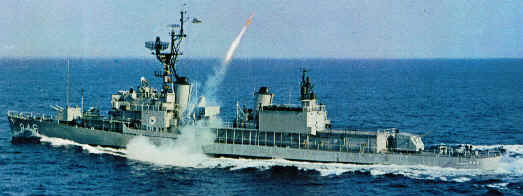 ASROC was 1 of 2 "new" weapon systems installed on FRAM Destroyers.
ASROC was 1 of 2 "new" weapon systems installed on FRAM Destroyers.
As seen left, the USS OZBOURN (DD-846) (FRAM 1 Gearing Class) is firing
its' ASROC from its' MK-112 ASROC launcher. With many built by the Diamond Match
Company, the MK-112 ASROC launcher was referred
to as the "Matchbox" ASROC launcher. What follows is a very
detailed description and history of ASROC.
PHYSICAL
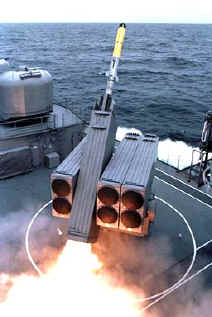 Description: ASROC is a three stage, solid fuel rocket comprised of a rocket
motor (MK 12), airframe assembly and a torpedo or depth bomb payload. Length was
fifteen feet, missile diameter twelve inches, overall diameter with stabilizing
fins thirty inches and weight approximately one thousand pounds. Description: ASROC is a three stage, solid fuel rocket comprised of a rocket
motor (MK 12), airframe assembly and a torpedo or depth bomb payload. Length was
fifteen feet, missile diameter twelve inches, overall diameter with stabilizing
fins thirty inches and weight approximately one thousand pounds.
OPERATION
ASROC equipped ships located and tracked submarines with sonar. After target
acquisition, data fed from the sonar to the fire control computer tracked the
submarine course, range and speed and the ASROC was aimed accordingly. Upon
firing the weapon, it flew to a pre determined splash point to deliver the
torpedo or depth bomb payload. The torpedo payload was slowed for water entry by
a parachute device and the torpedo transducer was protected at water entry by a
frangible nose cap.
HISTORY
Early in the 1950’s the Naval Ordnance Test Station
(N.O.T.S.) Pasadena, CA, demonstrated the feasibility of projecting a torpedo
with a rocket motor to provide an ASW standoff capability for surface ships.
This lead to the development of the Rocket Assisted Torpedo (RAT) which utilized
a 5” gun mount barrel and the MK 43 Torpedo for surface ship standoff
delivery. This program was carried
through shipboard evaluation. In the mid 1950s the Naval Ordnance Laboratory at
White Oak, MD conducted a study investigating several methods of delivering
missile payloads beyond the range capability of RAT. Subsequently the Naval
Oceans Systems Center (NOSC) San Diego and
N.O.T.S proposed an alternate system be developed called ASROC, and the
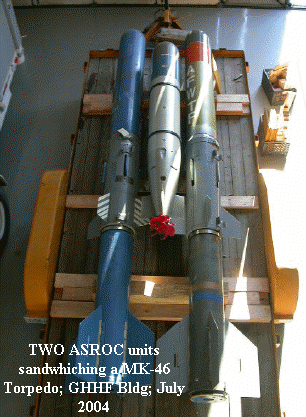 RAT system developed was terminated. RAT system developed was terminated.
In April of 1956, N.O.T.S. received approval from the Bureau of Ordnance to
initiate the development of ASROC and was assigned the role of Technical
Director of the weapons system as well design agent of the missile including the
adaptation kit, (depth charge less warhead) for the nuclear payload. In August
of 1956 CNO (Chief of Naval Operations) promulgated Development Characteristic
AS07101-1 which defined the requirement for both a nuclear payload and conventional acoustic homing torpedo delivery capability.
The MK 44 Torpedo that was under development at the time was selected as the
interim torpedo payload to be eventually replaced by an improved torpedo.
Minneapolis Honeywell Regulator Company was selected as the
prime contractor with Librascope Division of General Precision selected as
subcontractor for the fire control group
and the Armaments Division of Universal Match Corporation as subcontractor for
the launcher group. The Naval Ordnance Plant, York, PA was selected as the
development activity for the launcher power drives. The AN/SQS-23 Sonar, under
development by Sangamo Electric for the Bureau of Ships was to be integrated
into the ASROC system. The Los Alamos Laboratory was selected to develop the
nuclear warhead with Sandia Corporation, Albuquerque, NM. Extensive development
testing was conducted on the N.O.T.S. ranges at China Lake, Morris Dam and San
Clemente Island. The Navy conducted both independent tests and joint tests with
the Atomic Energy Commission (AEC) between 1956 and 1959.
In April of 1959 the entire system was brought together and installed on the USS
NORFOLK (DL-1)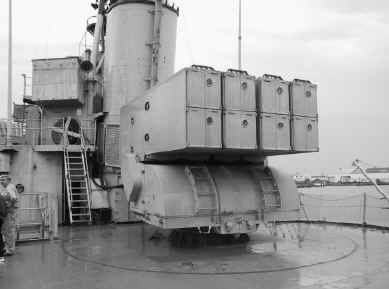 installation
was complete on a FRAM 1 ship, followed closely by the first of the DDG 2 Class
platforms. Installations continued at a rapid rate and the ASROC system
population eventually grew to over 200 ships. installation
was complete on a FRAM 1 ship, followed closely by the first of the DDG 2 Class
platforms. Installations continued at a rapid rate and the ASROC system
population eventually grew to over 200 ships.
In 1961 the
adaptation of ASROC to the MK 10
(TEROC) Terrier Guided Missile Launching System was initiated and ASROC with the
MK 17 Depth Charge payload obtained acceptance for service use. In 1962 a full
scale service test of ASROC with the new MK 17 Depth Charge was successfully
conducted and in 1963 the MK 114 Fire Control System, a follow on development to
replace the MK 111 Fire Control Group was completed and accepted for service
use. The MK 46 Mod 1 Torpedo was added as an ASROC payload in 1966 and by 1967
the evaluation of ASROC with the MK 10 Guided Missile Launching System was
completed.
In 1975 the MK
116 Mod 0 Fire Control System and the ASSDROC MK 4 Weapon Handling System was
accepted for service use on the DD 963 (SPRUANCE) class destroyers. In 1980 THE
MK 116 Mod 1 Fire control System was accepted for service use and integration of
ASROC into the MK 26 Guided Missile Launching System was completed. The last
installation of ASROC was aboard the TICONDEROGA Class
USS THOMAS GATES (CG 51). The ASROC system was phased out of the U.S.
Navy in the 1990s in favor of the MK 41 Vertical Launch System and the Vertical
ASROC missile.
The Gyrodyne Helicopter
Historical Foundation wishes to thank the "Old Sailor" for providing
us with the above ASROC information and his continued assistance so we
could get it right!
Thank you, so very much,
Old Sailor!

|
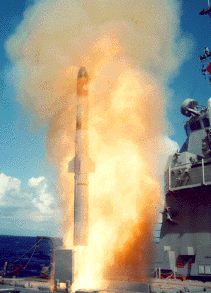
Another Sailor...has written the loading
protocol. Click on the ASROC at left to Go there!
|
|

|
 What
was the Reliability of the predecessor to ASROC, as seen from a sailor's stand point? What
was the Reliability of the predecessor to ASROC, as seen from a sailor's stand point?
Many have heard about the stories of the
QH-50 DASH "that took off at a certain bearing.....and for all we
know it is still flying......" BUT what of WEAPON ALPHA which
preceded ASROC?
|
|

|

   

|





![]()